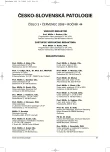S-100 Protein Positivity in Osteogenic Tumours and Tumour-like Bone Forming Lesions
Authors:
C. Povýšil; R. Kaňa; M. Horák
Authors‘ workplace:
Oddělení otorinolaryngologie VFN, Praha
; Oddělení zobrazovacích metod Nemocnice Na Bulovce, Praha
; Ústav patologie 1. LF UK a VFN a Katedra patologické anatomie IPVZ, Praha
Published in:
Čes.-slov. Patol., 44, 2008, No. 3, p. 59-61
Category:
Original Article
Overview
Various osteogenic tumours and bone producing tumour-like lesions of bone were examined for S-100 protein using the immunostaining methods. The positive reaction for S-100 protein of some bone cells was detected not only in osteoblastic osteosarcomas and osteoblastomas, but also in osteoplastic reactive lesions, fibrous dysplasia, Paget’s disease and in the tissue of the bony callus. The positive reaction for osteocalcin in these cells showed, that they may be of osteoblastic and osteocytic lineage. The S-100 protein positive bone cells have to be differentiated from chondrocytes persisting in new-formed bone trabecullae. On the one hand S-100 protein positive osteocytes and osteoblasts may represent transient form of osteocytes histogenetically related to chondrocytes , but we were not able to prove such suggestion. Therefore, S-100 protein positivity can be caused by polyclonal character of the used antibody, that is a mixture of three antibodies, S-100 A1, A6 and anti B2. The specificity of these three components differs depending on the histogenesis of cells and their functional status. Such explanation is supported by the results of our study, because we also observed intense positivity of bone cells in the reaction with monoclonal antibody against S-100A6. In contrast, no staining of bone cells was detected with monoclonal antibodies against S-100 A1 and B2.
Key words:
bone cells – osteogenic tumours – tumour-like lesions – S-100 protein – immunohistochemistry
Sources
1. Cross, S.S., Hamdy, F.C., Deloulme, J. C. et al.: Expression of S-100 proteins in normal human tissues and common cancers using tissue microarrays: S100A6, S100A8, S100A9 and S100A11 are all overexpressed in common cancers. Histopathology, 46, 2005, s. 256-269.
2. Donato, R.: Functional roles of S100 proteins, calcium-binding proteins of the EF-hand type. Biochimica et Biophysica Acta (BBA)-Molecular Cell Research, 1450, 1999, s. 191-231.
3. Ishida, T., Dorfman, H.D.: S-100 protein in osteogenic tumors. Am. J. Surg. Pathol., 18, 1994, s. 857-858.
4. Okajima K., Honda, I., Kitagawa, T.: Immunohistochemical distribution of S-100 protein in tumors and tumor-like lesions of bone and cartilage. Cancer, 61, 1988, s. 792-799.
5. Weiss A. P. C., Dorfman H. D.: S-100 protein in human cartilage lesions. J. Bone Joint Surg., 68A, 1986, s. 521-526.
Labels
Anatomical pathology Forensic medical examiner ToxicologyArticle was published in
Czecho-Slovak Pathology

2008 Issue 3
Most read in this issue
- Thrombotic Microangiopathies: Thrombotic Thrombocytopenic Purpura (TTP) and Hemolytic Uremic Syndrome (HUS). Morphological Features, Differential Diagnosis, and Pathogenesis. Review Article
- Spontaneus Abortion Caused by Listeria monocytogenes – Report of Three Cases
- Expression of CD34 and CD117 in Juxtaglomerular Cell Tumor of Kidney
- Fibrosis Identified in the Bone Marrow Biopsies of Patients with Essential Thrombocythemia: its Incidence and Significance for the Differential Diagnostic Considerations
